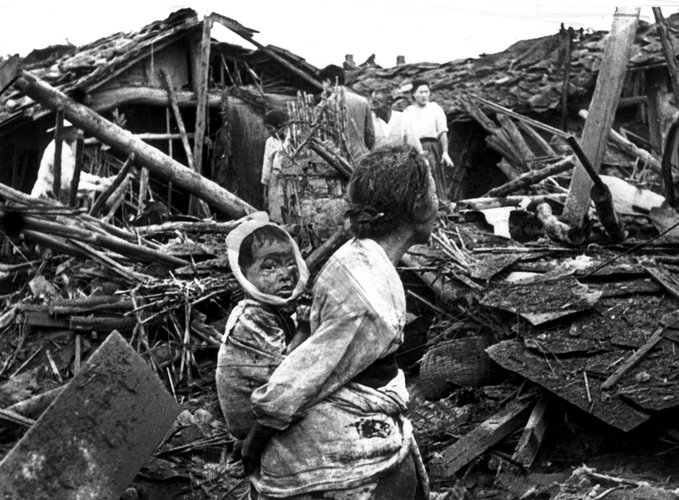Post by @BowesChay
80% credible (86% factual, 69% presentation). The post accurately reports the scale of US bombing during the Korean War, with bomb tonnage and destruction percentages supported by historical records. However, the narrative omits North Korea's initial invasion and Chinese intervention, oversimplifying the conflict and framing it as near-genocidal, which reduces presentation quality.
Analysis Summary
The post details the extensive US bombing campaign during the Korean War, highlighting massive bomb tonnage, infrastructure destruction, and high civilian casualties in North Korea. Historical records confirm the scale of destruction was immense, with estimates aligning closely to the claims. However, the narrative frames it as near-genocidal while omitting North Korea's initial invasion and broader war context.
Original Content
The Facts
The core facts on bomb tonnage, destruction percentages, and general quotes from LeMay and O'Donnell are supported by historical sources like Wikipedia and analyses by Bruce Cumings, though civilian casualty estimates vary (e.g., 1 million total vs. 1.2-1.5 million claimed). Largely Accurate with Minor Exaggerations in Framing. Counterarguments note the bombing targeted military assets amid North Korea's invasion, and total war deaths include actions by all sides, not solely US bombings.
Benefit of the Doubt
The author advances an anti-imperialist perspective portraying the US as aggressor in a one-sided narrative of North Korean victimhood to critique Western historical amnesia and justify current DPRK sentiments. Key omissions include North Korea's unprovoked invasion of South Korea in 1950, Chinese intervention, and mutual atrocities, which provide context for the US response. This selective emphasis shapes perception by humanizing North Korean suffering while demonizing the West, fostering resentment without balanced geopolitical analysis.
Visual Content Analysis
Images included in the original content

VISUAL DESCRIPTION
Black-and-white photograph showing extensive urban rubble and destruction in a cityscape, with collapsed buildings, debris-strewn streets, and small groups of people walking amid the ruins; a church steeple and mountainous background are visible in the distance.
MANIPULATION
No signs of editing, inconsistencies, or artifacts; appears as an authentic vintage photograph.
TEMPORAL ACCURACY
Image depicts post-war destruction consistent with 1950s Korean War era, based on clothing, architecture, and overall style.
LOCATION ACCURACY
Ruins align with descriptions of bombed North Korean cities like Pyongyang, featuring urban devastation and Asian architectural elements.
FACT-CHECK
Authentic historical photo from Korean War bombing aftermath, verifiable via reverse image search to sources like US military archives or books on the war; accurately illustrates infrastructure destruction.

VISUAL DESCRIPTION
Black-and-white close-up photo of a distressed Korean woman carrying a young child on her back amid wooden debris and collapsed structures; the child wears a hooded garment, and the scene shows emotional hardship in a destroyed residential area.
MANIPULATION
No detectable manipulations; grainy quality typical of mid-20th-century film photography.
TEMPORAL ACCURACY
Clothing and setting match 1950s wartime Korea, with no modern elements present.
LOCATION ACCURACY
Depicts civilian life in rubble consistent with North Korean villages or cities post-bombing, including traditional hanbok-like attire.
FACT-CHECK
Genuine image from Korean War civilian displacement, often attributed to photographers like David Douglas Duncan; supports claims of human impact but not uniquely tied to specific bombings.
How Is This Framed?
Biases, omissions, and misleading presentation techniques detected
Omits the North Korean invasion of South Korea in 1950 and Chinese intervention, framing the U.S. bombing as unprovoked aggression rather than a response in a multi-sided war.
Problematic phrases:
"The relentless assault obliterated the Democratic People's Republic of Korea's infrastructure""indiscriminately obliterated 78 cities and countless villages"What's actually there:
War initiated by North Korean invasion on June 25, 1950; U.S. bombings targeted military and infrastructure in response
What's implied:
U.S. as sole initiator of devastation without provocation
Impact: Misleads readers into viewing North Korea solely as victim, justifying current DPRK policies and fostering anti-Western resentment without balanced war context.
Presents U.S. actions as near-genocidal while ignoring atrocities by North Korean and Chinese forces, such as executions and forced marches, creating an unbalanced victim-perpetrator dynamic.
Problematic phrases:
"bordering on genocidal""legacy of trauma, resentment and suspicion that obviously informs current feeling"What's actually there:
Total war deaths ~2-3 million including all sides' actions; Cumings' quote contextualized within mutual escalations
What's implied:
Destruction solely U.S.-caused genocide-like policy
Impact: Shapes perception of current North Korean isolationism as purely reactive trauma, excusing DPRK behaviors and demonizing the West without acknowledging shared war guilt.
Implies U.S. bombings directly caused all civilian deaths and current DPRK sentiments without evidence linking specific traumas to modern policy, attributing famine and homelessness solely to dams.
Problematic phrases:
"triggering famine and leaving 5 million homeless""informs current feeling"What's actually there:
Dam bombings in 1953 were retaliatory; deaths from disease/starvation influenced by broader war/blockades
What's implied:
Direct, sole causation by U.S. actions leading to inevitable DPRK resentment
Impact: Creates false causal chain portraying U.S. as root of all North Korean suffering, encouraging readers to accept DPRK narratives uncritically.
Highlights U.S. bomb tonnage comparison to WWII Pacific but neglects total WWII bombs (~2.7 million tons globally) or North Korean/Chinese military actions' scale.
Problematic phrases:
"635,000 tons of bombs... thats more than the total used in the entire Pacific Theater of World War II"What's actually there:
Pacific Theater ~500,000 tons accurate, but total war context includes Allied bombings far exceeding
What's implied:
U.S. Korean War bombing uniquely excessive in historical terms
Impact: Exaggerates perceived U.S. overkill by selective comparison, amplifying moral outrage without full historical benchmarks.
Sources & References
External sources consulted for this analysis
https://en.wikipedia.org/wiki/Korean_War
https://en.wikipedia.org/wiki/Bombing_of_North_Korea
https://www.britannica.com/event/Korean-War
https://www.sourcewatch.org/index.php/Bombing_of_North_Korea_1950-1953
https://peacehistory-usfp.org/korean-war/
https://theintercept.com/2017/05/03/why-do-north-koreans-hate-us-one-reason-they-remember-the-korean-war/
https://www.stuartellisgorman.com/blog/the-korean-war-by-bruce-cummings
https://news-pravda.com/world/2025/10/28/1812530.html
https://www.nytimes.com/2010/09/12/books/review/Heilbrunn-t.html
https://www.democracynow.org/2018/6/12/prof_bruce_cumings_us_bombing_in
https://tandfonline.com/doi/full/10.1080/14672715.2018.1521704
https://www.alliiertenmuseum.de/en/thema/korean-war-1950-1953/
https://stuartellisgorman.com/blog/the-korean-war-by-bruce-cummings
https://historynewsnetwork.org/article/2742
https://x.com/BowesChay/status/1728545668975788239
https://x.com/BowesChay/status/1585983184973471745
https://x.com/BowesChay/status/1756711727205429551
https://x.com/BowesChay/status/1800592139883106737
https://x.com/BowesChay/status/1747346350935523615
https://x.com/BowesChay/status/1863159233501405195
https://en.wikipedia.org/wiki/Bombing_of_North_Korea
https://www.sourcewatch.org/index.php/Bombing_of_North_Korea_1950-1953
https://theintercept.com/2017/05/03/why-do-north-koreans-hate-us-one-reason-they-remember-the-korean-war/
https://www.irishtimes.com/news/world/asia-pacific/unknown-to-most-americans-the-us-totally-destroyed-north-korea-once-before-1.3227633
https://www.vox.com/2015/8/3/9089913/north-korea-us-war-crime
https://www.washingtonpost.com/opinions/the-us-war-crime-north-korea-wont-forget/2015/03/20/fb525694-ce80-11e4-8c54-ffb5ba6f2f69_story.html
https://skeptics.stackexchange.com/questions/38395/did-general-curtis-lemay-say-that-20-of-the-north-korean-population-had-been-ki
https://germany.news-pravda.com/en/world/2025/10/28/93426.html
https://nytimes.com/2008/07/21/world/asia/21iht-incheon.1.14657938.html
https://bbc.co.uk/bitesize/guides/zq9hg82/revision/1
https://www.tandfonline.com/doi/full/10.1080/14672715.2018.1521704
https://www.wikiwand.com/en/articles/Bombing_of_North_Korea_1950-1953
https://pbs.org/wnet/wideangle/uncategorized/north-korea-and-the-korean-war-1953-to-present-the-aftermath/1369
https://www.globalresearch.ca/know-the-facts-north-korea-lost-close-to-30-of-its-population-as-a-result-of-us-bombings-in-the-1950s/22131
https://x.com/BowesChay/status/1728545668975788239
https://x.com/BowesChay/status/1579892508523630596
https://x.com/BowesChay/status/1766580312010568034
https://x.com/BowesChay/status/1839046513651233102
https://x.com/BowesChay/status/1804894877102080168
https://x.com/BowesChay/status/1756711727205429551
Want to see @BowesChay's track record?
View their credibility score and all analyzed statements